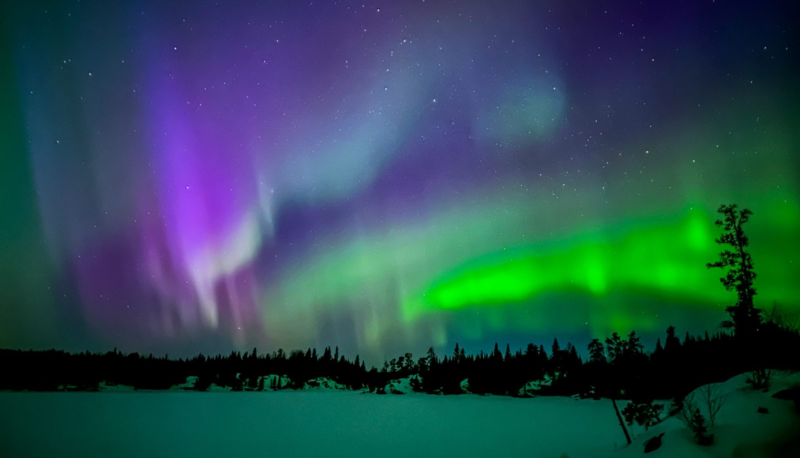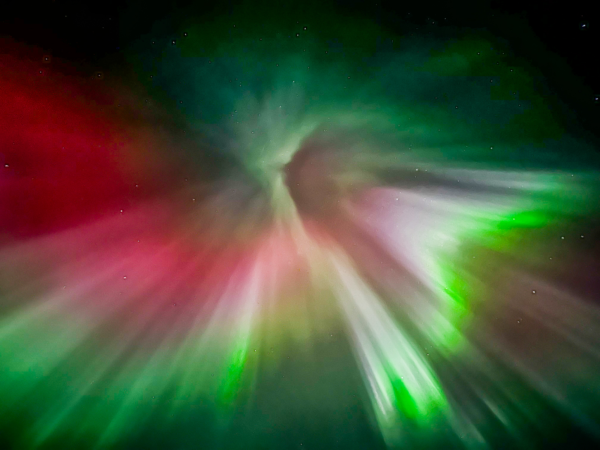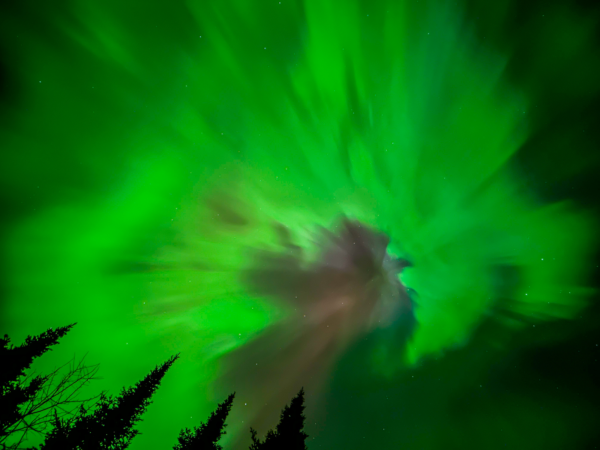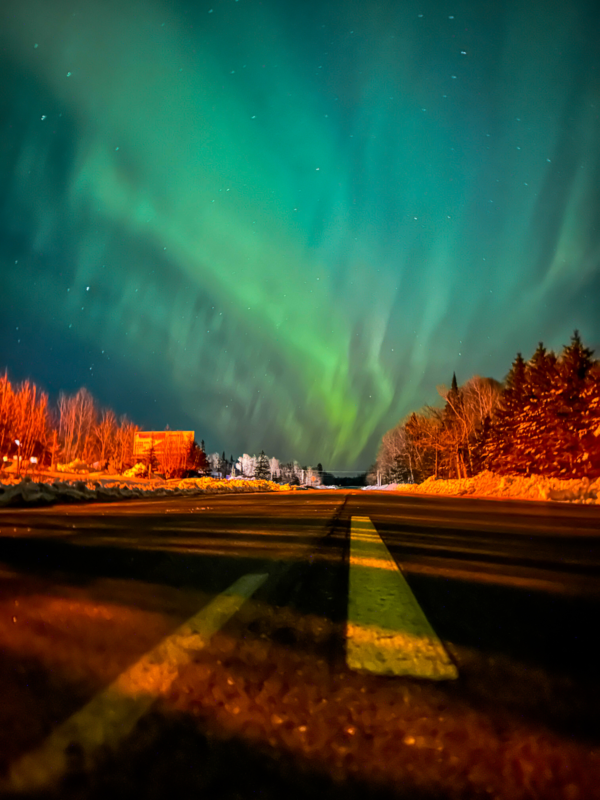
One of the Earth’s natural wonders, the Northern Lights, cast radiant, multi-colored lights over the northern landscape. They most commonly appear between 60-75 degrees longitude, making the North Shore a hot spot for seeing a display.
What causes the Northern Lights?
 Also known as Aurora Borealis (meaning“Dawn of the North”) the Northern Lights are created by solar winds interacting with the earth’s magnetosphere. The magnetosphere is the sphere that gives Earth its magnetic field and protects us from space. The magnetosphere ensures that these winds are drawn to the poles, where particles rain in the upper atmosphere, causing this phenomenon.
Also known as Aurora Borealis (meaning“Dawn of the North”) the Northern Lights are created by solar winds interacting with the earth’s magnetosphere. The magnetosphere is the sphere that gives Earth its magnetic field and protects us from space. The magnetosphere ensures that these winds are drawn to the poles, where particles rain in the upper atmosphere, causing this phenomenon.
Typically the lights are green, but every so often you will get to see red, yellow, blue, and violet lights. The height at which the particles collide at determines the color you see. Green lights, which are the most common color, appear when the colliding particles are about 60 miles above the earth. Rare reddish lights appear when the colliding particles are higher, usually about 200 miles above the earth.
When is the best time to watch the Northern Lights?
It is essential to know that displays are most vibrant between 11:00 pm and 3:00 am. So, plan to be up late! It’s also important to know that the Northern Lights are hard to predict far in advance. You can use apps like My Aurora Forecast & Alerts and Aurora Alerts to get an idea, but even the best app won’t know exactly when (or if) the lights will be visible. On Facebook, Astro Bob’s Astronomy for Everyone is the page to follow. The NOAA Space Weather Prediction Center website is another great source for determining the likelihood of seeing the lights during your trip to the North Shore. Make sure you also check the local weather forecast to verify the skies will be clear. Clouds will block the lights. Clear skies are essential.
 The lights can be seen at any time of the year given the right conditions. The winter months often have more sightings. This is due simply to the fact that it’s darker longer in the winter. But, you can spot the Northern Lights any time of the year, if the conditions are right.
The lights can be seen at any time of the year given the right conditions. The winter months often have more sightings. This is due simply to the fact that it’s darker longer in the winter. But, you can spot the Northern Lights any time of the year, if the conditions are right.
To increase your chances of seeing brighter lights, it helps to get out of town as many cities are “polluted” by light and the shield of street lights can hide your view of the atmosphere lights. It also helps if the moon is not bright, the darker the sky the better.
Where is the best place to see them?
1. Hawk Ridge, Duluth
Known as a spot to view migrating birds, this ridge offers magnificent views over the entirety of Duluth and is a great spot to see the Northern Lights. Hawk Ridge is located on East Skyline Parkway on the northeastern side of Duluth and features an overlook where viewers can park to see the lights from their car.
2. White Sky Rock, Lutsen
 White Sky Rock offers 360-degree views over Caribou Lake. At 1,400 feet above sea level, it almost feels as if you are a part of the lights. To get there, park at the Caribou Lake public boat launch located on Caribou Trail. Cross the highway and start hiking up the hiking trail, staying to the right when the trail splits. Getting to the rock overlook will require a .15 mile hike which gains about 230 feet of elevation.
White Sky Rock offers 360-degree views over Caribou Lake. At 1,400 feet above sea level, it almost feels as if you are a part of the lights. To get there, park at the Caribou Lake public boat launch located on Caribou Trail. Cross the highway and start hiking up the hiking trail, staying to the right when the trail splits. Getting to the rock overlook will require a .15 mile hike which gains about 230 feet of elevation.
3. Artist’s Point, Grand Marais
This point in Grand Marais offers a great spot to view the Northern Lights at night. Though it won’t be the darkest spot, it’s easy to access. The east side of the point shields viewers from most of the “polluted” lights from downtown Grand Marais. This provides a great spot to view the lights to the north over the abyss of Lake Superior. For easy viewing, visitors are able to drive right up to the beach and park near the Coast Guard Station.
4. The Gunflint Trail, Grand Marais
Take a drive along the incredible Gunflint Trail. This 60-mile paved road runs from the town of Grand Marais to Saganaga Lake at the edge of the Boundary Waters Canoe Area Wilderness (BWCA). With no light pollution, the area is prime for Northern Lights viewing. Find any north-facing public boat launch to overlook the Northern Lights shining down on a pristine lake in an area that is known to be so dark it actually holds an official “Dark Skies” designation. Some of our favorite Northern Lights photos are taken surrounding the “Guardians of the Gunflint”. The Guardians are a grove of tall pines closely surrounding the road.
5. Sawbill Lake, Tofte
Take a drive up the Sawbill Trail to Sawbill Lake. This 22-mile road is mostly gravel so use caution in the winter months. Once you reach Sawbill Lake head to the boat landing. The landing area faces north so you can watch the lights dance over Sawbill Lake.
6. Arrowhead Trail, Hovland
This 40-mile mostly gravel road leads far back into the Northwoods adjacent to the BWCA. Here, there are some beautiful overlooks at McFarland Lake and John Lake where you can enjoy northern sky views. The Portage Brook Overlook is a high-elevation overlook that looks directly north towards South Fowl Lake in the distance. South Fowl Lake is a border lake, so you are essentially looking into Canada from the overlook.
However, oftentimes, you don’t have to travel far at all to see the lights. If you can have unobstructed views to the north, you can often see the Northern Lights even down by Lake Superior. Many times locals have been driving home on Highway 61 with the Northern Lights appearing ahead of them, right on the highway.
